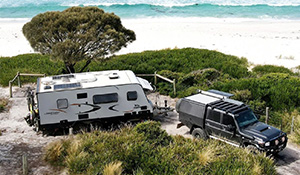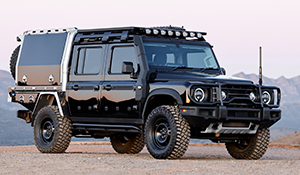Toyota C-HR arrives
Toyota’s new C-HR has landed in Australia, with the funkily-styled compact crossover SUV aiming for the likes of the Nissan Juke and Kia Soul in the urban market.
Available in two model grades - standard and Koba - pricing for the C-HR starts at $26,990 for the entry level 2WD manual, rising to $28,990 for the 2WD CVT version. Choosing AWD adds a further $2,000 for $30,990. The C-HR Koba adds a number of luxury, tech and appearance features over the standard model, priced from $33,290 for the 2WD CVT and $35,290 for the AWD CVT (all pricing excludes ORCs).
"C-HR will bring new customers to the Toyota brand - typically younger, image-conscious people who take a more emotional approach to purchasing a car compared with our more traditional customers," said Tony Cramb, Toyota Australia's executive director sales and marketing.
"Owners will appreciate C-HR's refined engine, its supple chassis, premium airy interior - and the bonus of excellent fuel economy.”

TNGA and Turbo First
The C-HR is built on the ‘Toyota New Generation Architecture’ (TNGA) platform, which Toyota says offers a “fluent, engaging driving behaviour due to its exceptional rigidity, low centre of gravity and optimised suspension layouts.”
TNGA sees all key mechanical components placed lower in the overall body structure, which allowed designers to lower bonnet height for improved vision and drop roof height without compromising headroom.
Suspension consists of independent MacPherson strut front and double wishbone rear arrangements that Toyota said have been specifically developed for this model and deliver handling like a hatchback, as well as smoother, more accurate steering.
The C-HR’s 1.2-litre four-cylinder turbocharged petrol engine is a first in an Australian-delivered Toyota. Driving the front wheels, the 1.2 turbo produces 85kW and 185Nm, with combined fuel economy listed at 6.5lt/100km for the AWD version.
Response from the turbo four can be adjusted using the 3-mode control (for CVT models only), with a choice of Normal, Eco or Sport, all of which adjust the steering feedback and CVT performance, as well as the throttle response.

Advanced AWD
The part-time AWD system on the C-HR features Toyota’s Dynamic Torque Control (DTC) - an electromagnetic system that can direct up to half of torque to the rear axle.
Using electronic sensors, the DTC measures speed, yaw rate, steering and throttle angles to automatically control torque distribution.
Toyota claims that DTC saves fuel by driving only the front wheels when the vehicle is cruising, switching to AWD when needed via an electromagnetically controlled coupling in the rear diff housing.
As soon as the driver starts to turn the steering wheel, the system directs 10 per cent of available torque to the rear wheels. This ensures good response to changes in the steering angle when cornering.
Yaw-rate feedback control is designed to correct understeer and oversteer every six milliseconds through optimal control of the front-rear torque split, up to a maximum of 50/50.
Allied to this are front wheel sensors that monitor irregularities in the road surface and adjust torque delivery to the driven front axle accordingly. For example, when the vehicle’s nose drops, drive force in increased to counter the extra loading over the driven front wheels. The reverse applies when the nose lifts.

Styled to Stand Out.
On its compact platform (4360mmL x 1795mmW x 1565H – marginally larger than a Corolla hatchback) and 2640mm wheelbase, Toyota have packed a lot into the five-seat C-HR, with the TNGA platform allowing for more freedom with the exterior styling, whole also delivering more interior space.
Externally, the C-HR and C-HR Koba feature the same coupe-styled design. Toyota call the mix of sharp lines and soft curves “diamond architecture” which, in this production version, is the result of concepts dating back to 2014, while the front end bears a more immediate resemblance to the revised RAV4 released here last year.
In addition to the low bonnet and coupe rear, the design is highlighted by chunky, flared wheelarches, blacked-out sill panels, hidden rear door handles, headlight clusters that almost stretch back to the trailing edge of the bonnet, and tail lights that project from the body.
Unseen are aerodynamic underbody panels designed to reduce drag and improve fuel efficiency.
It’s a bold design, but also cohesive and should find favour with the younger buyers (particularly those who fancy Hyundai’s Veloster, for example) that Toyota are aiming this model at.

Safety Spec
Well-equipped in terms of active and passive safety tech, the C-HR features seven airbags, front and rear parking sensors, rain-sensing wipers and a reversing camera.
The C-HR’s pre-collision system includes autonomous emergency braking, active cruise control, lane departure alert with steering assist and auto high beam headlights.
Also standard is blind spot monitoring, rear cross traffic alert, hill start assist, ABS with EBD and brake assist, a brake hold function, stability and traction control.
The C-HR also comes with standard trailer sway control, although the amount of buyers looking to haul with this model would have to be minimal. A maximum 600kg braked towing capacity on the AWD CVT models limits options here anyway.

Standard or Koba
The standard C-HR features all of the aforementioned safety tech, as well as 17-inch alloys, halogen headlights, roof and tailgate spoilers, 6.1-inch infotainment screen, satnav, Bluetooth, 4.2-inch multi-information display, power mirrors, puddle lamps, shark fin antenna and 12V socket.
Above this sits the Koba, which takes its name from the C-HR’s chief engineer, Hiroyuki Koba.
This variant’s most obvious difference is the contrast-colour roof panel, but the Koba also adds 18-inch alloys, LED front and rear lights, keyless entry/ignition, leather-accented seats with heating and a power adjustable driver’s seat, illuminated door trims, illuminated sunvisors, privacy glass and ‘Nano-e’ air purification. Nano-e is an upgrade on the air con system that moisturises cabin air to neutralise, odours, bacteria and allergens.

Accessories Galore
In addition to a choice of eight exterior colours and the aforementioned two-tone treatment on the Koba, the C-HR will also feature abundant personalisation options, with more than 60 Toyota Genuine accessories available, including various wheel designs, exterior garnish items, roof racks and more. The range of accessories is second only to the HiLux in Toyota’s range.




















